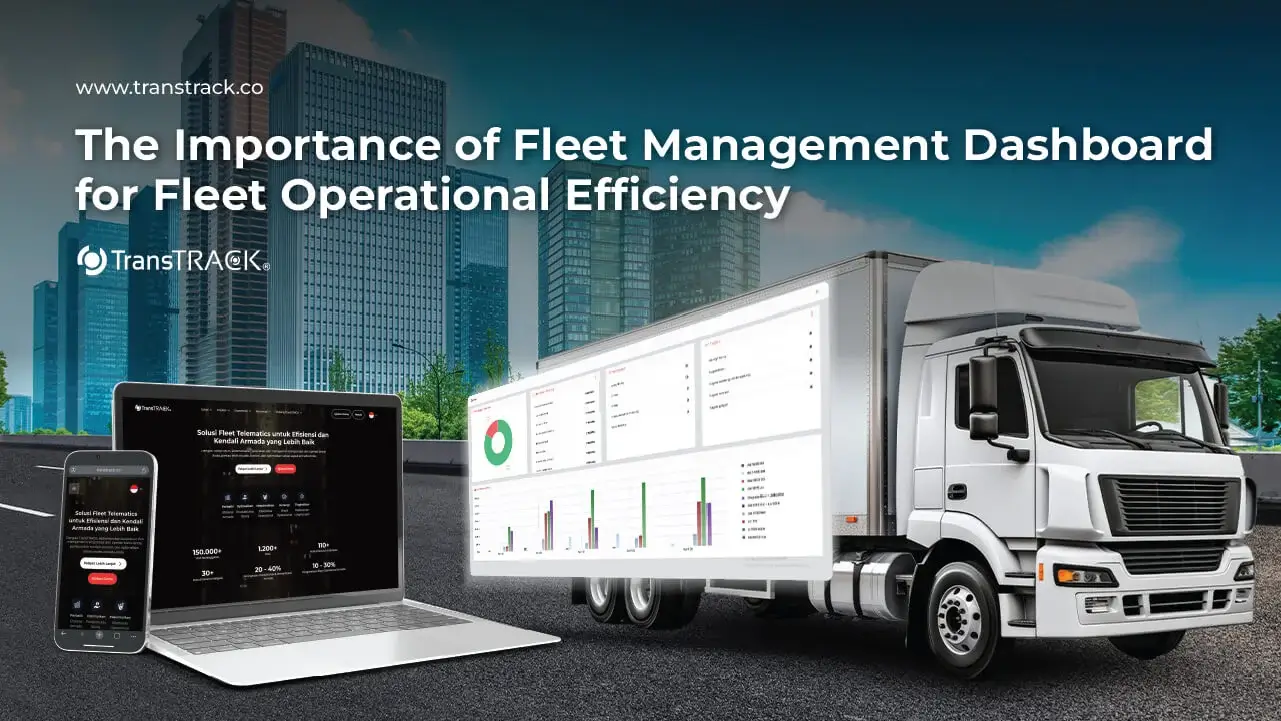The Importance of Fleet Management Dashboard for Fleet Operational Efficiency
Posted on April 24, 2025 by Nur Wachda Mihmidati

In an increasingly fast-paced business world, vehicle fleet management is one of the important aspects in achieving operational efficiency. Fleet Management Dashboard comes as a sophisticated solution to monitor and manage fleets in real-time, provide better visibility, and assist data-driven decision making. With a variety of excellent features, this dashboard not only facilitates vehicle monitoring, but also helps companies to reduce costs, improve safety, and optimize fleet productivity.
Are you ready to take your fleet management to the next level? By using the right system, you can get the most out of every vehicle you own. Check out the following article TransTRACK!
What is Fleet Management Dashboard?
Fleet Management Dashboard is an interactive visual system designed to monitor, manage, and analyze vehicle fleet operations in real-time. Through an easy-to-understand display, the dashboard presents important data such as vehicle location, operational status, driver behavior, and vehicle technical conditions. This information helps companies optimize travel routes, reduce operational costs, and improve overall fleet efficiency and productivity.
In addition to monitoring functions, Fleet Management Dashboard also plays an important role in safety and regulatory compliance. Features such as periodic service notifications, geofencing, automated reporting, and fuel consumption analysis allow companies to keep their fleets in top condition while minimizing operational risks. This dashboard is widely used by the logistics sector, public transportation, mining industry, plantations, and other companies that depend on vehicles as a major part of business operations.
What are the functions of dashboards in fleet management?
Here are the functions of dashboards in fleet management:
- Real-Time Monitoring Display live vehicle location and status to ensure operations are on track.
- Operational Management Manage vehicle routes, schedules, and activities for time and cost efficiency.
- Driver Behavior Monitoring Records data such as speed, sudden braking, or stop duration to improve safety and work discipline.
- Fleet Maintenance Provides notifications for periodic servicing, engine checks, and detects potential breakdowns.
- Analytics and Reporting Provides automated reports on fuel usage, mileage, fleet performance, and productivity.
- Security and Compliance Supports features such as geofencing, panic buttons, and tracking compliance with operational standards and regulations.
- Data-driven Decision Making Assists management in making strategic decisions with accurate and structured data.
Key Features of Fleet Management Dashboard
Fleet Management Dashboard is designed to provide full visibility into fleet activities in an efficient and measurable manner. With a variety of integrated features, this dashboard helps companies manage their fleet more intelligently, safely and cost-effectively. Here are the main features that are the mainstay of the Fleet Management Dashboard system:
Live Visualization of Fleet Position and Status
Display the real-time location and status of the fleet through an interactive map, making it easier to monitor vehicle movements and make quick decisions.
Monitoring Fuel Consumption, Speed, and Idle Time
Monitor vehicle operational efficiency by recording fuel usage, average speed, as well as the duration the vehicle is running but not moving.
Alert System for Driver Behavior
Send instant notifications if risky driving behaviors such as sudden braking, extreme acceleration, or speed and route violations are detected.
Periodic Fleet Performance Reports
Provide regular fleet performance reports, including vehicle utilization, efficiency, and maintenance history to support operational evaluation.
How does a fleet management dashboard work?
Fleet Management Dashboard involves the integration of hardware and software to collect, process and display fleet data in real-time. The system works automatically to provide full visibility of vehicle operations. Here are the general steps:
1. Data Collection from the Vehicle
Sensors and GPS devices are installed on the vehicle to record data such as location, speed, fuel consumption, driving behavior, and engine status.
2. Data Transmission to Server
Data from vehicles is sent automatically via cellular or satellite networks to a central server or cloud that manages the fleet management system.
3. Data Processing and Analysis
The system processes the data and turns it into easy-to-understand information-such as route graphs, efficiency reports, or alert notifications.
4. Data Display on Dashboard
All information is displayed on a dashboard that can be accessed via web or app, so users can monitor the fleet anytime and from anywhere.
5. Data-Driven Actions
Fleet managers can take action based on available information-such as rearranging routes, scheduling services, or reprimanding drivers who violate SOPs.
How to Start Fleet Dashboard Implementation
Starting the implementation of Fleet Management Dashboard requires careful planning and systematic steps. The following are the steps that are generally taken to start implementing a fleet management dashboard:
1. Identify Needs and Objectives
- Determine what you want to achieve with the dashboard, such as reducing operational costs, improving safety, or optimizing vehicle routes.
- Identify relevant metrics, such as fuel consumption, travel time, or driver behavior.
2. System and Platform Selection
- Choose a dashboard platform that suits your needs and budget. Many platforms offer various features and levels of flexibility.
- Ensure that the chosen platform is compatible with existing hardware, such as GPS sensors and vehicle telemetry.
3. Hardware Installation
- Install GPS devices, fuel sensors, and other telematics devices in the vehicles to collect the necessary data.
- Ensure that all vehicles involved are connected to the right systems.
4. Integration with Existing Systems
- Integrate the dashboard with other systems already in use, such as vehicle management systems, maintenance software, or the company’s ERP.
- Make sure the systems can share data with each other to improve operational efficiency.
5. User Training
- Train fleet managers, drivers and other users to understand how to use the dashboard and interpret the data displayed.
- Provide training on how to utilize automated alerting and report generation features.
6. Trial and Adjustment
- Conduct a trial implementation on a small part of the fleet to identify potential problems and shortcomings of the system.
- Adjust settings and configurations according to user feedback.
7. Full Rollout
- After a successful trial, fully deploy the system to the entire fleet and start monitoring vehicle performance through the dashboard.
- Ensure system maintenance is carried out regularly to ensure the data remains accurate and up-to-date.
8. Evaluation and Optimization
- Regularly evaluate the performance of the system by looking at the reports and metrics generated by the dashboard.
- Make improvements or adjustments if needed to continuously improve the efficiency and effectiveness of fleet operations.
In conclusion, Fleet Management Dashboard provides many benefits to monitor, manage, and optimize vehicle fleets more efficiently and intelligently. With features such as real-time monitoring, fuel consumption management, and periodic performance reports, this dashboard helps companies to improve safety, reduce operational costs, and increase productivity.

If you want to optimize your fleet management with a customizable solution, use Fleet Management System from TransTRACK. With advanced technology that supports vehicle tracking, route management, and in-depth data analytics, TransTRACK provides full visibility and more control over your fleet. <Contact us now to start your journey towards more efficient and effective fleet management with TransTRACK!
Recent Post
Topic :
 Bahasa Indonesia
Bahasa Indonesia









